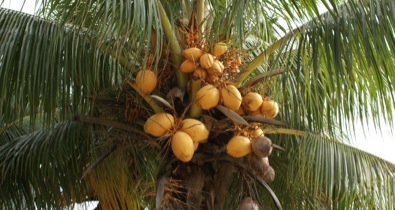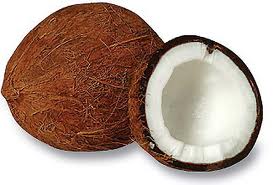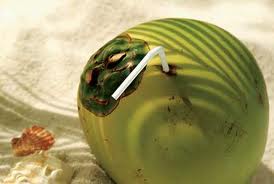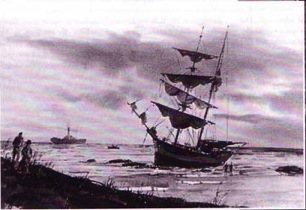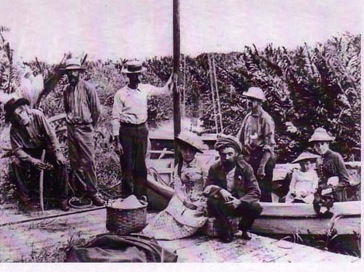Coconut, An Equatorial Palm
Popular media and commercial production have made the coconut a common cultural item, even if you live thousands of miles away from where it grows. More so, the coconut is at the heart of nutritional controversy.
What could be controversial about coconut? The answer is coconut oil. It is a saturated fat in an age that tries to condemn saturated fats. Thus an oil that was once used in a multitude of products was banished to the economic hinterlands for several decades. However, advocates of the nut say the oil is a short-chain saturated fat, not like saturated fats from animal products, and thus, not harmful but actually extremely healthy and a disease preventative. This writer falls on the healthy side of the debate. I eat a lot of coconut and use the oil as my standard “hot” cooking oil along with olive oil, my “cold” oil. To date, now 70, my blood lipids are excellent (and no, I am not a vegetarian but rather a low-carbing ..ah… meat-atarian.) I think I am the only person my age not taking statin drugs. In fact, I take no medications and work on keeping it that way.
What moved me over into the coconut camp was the work of Dr. Mary Enig, a lipid researcher. She wrote one time that you could see a study done on coconut oil in which the data showed it was healthful yet the study’s conclusion would say it was not. I thought that rather silly if not doubtful until one day I read several reports exactly like that including a meta analysis. The reason given was that if the researchers wanted more research funds they had to have a summary conclusion that agreed with the nutritionally politically correct stance of their era, read anti-coconut. But enough of food politics and my fat opinion, what of the coconut palm?
It is found in tropical climates, from about 26 degrees north and south of the equator. It likes humidity so does not take well to warm desserts. It is common in south Florida but is also reported in isolated areas in South Carolina, California, Texas, Hawaii and in Puerto Rico. They can be found almost up to central Florida but look a bit ratty from the cooler winters.
Coconuts are probably native to the southwest Pacific. From there they found their way to Africa and from there to the New World. Another theory is that it came from Southeast Asia. In either case coconuts were first written about around 60 AD, in Africa, in an area or town called Rhapta (and here is why language is so important to botany.) The natives there used coconut fibers to build their boats, actually sewing. In Greek “raftis” is a tailor and “rafto” to sew, a word that is similar in Arabic. The Portuguese were the first outsiders to see the boats sewn and from there the coconut spread. Also, the coconut floats and the palm is salt tolerant, so it moved itself around the world as well.
Coconuts came to Florida by accident. On 9 January 1878, the ship Providencia wrecked off-shore at what is now Palm Beach carrying 20,000 coconuts. Unexpectedly liberated, the coconuts floated ashore and found Florida to their liking. They sprouted enmasse on the beach. That is how Palm Beach got its name (though Coconut Beach would seem more appropriate.)
The Providencia was a 175-ton square rigged brig. It was going from Havana to Cadiz, Spain. By all accounts the weather was excellent, the day pleasant, and it was never ascertained exactly why the ship wrecked where it did. Fortuntely it was carrying a lot of wine and cigars so a party soon developed on shore which reportedly lasted two weeks. A steamer later picked up the crew and took them to Key West which at the time was a large city in comparison. It is speculated the crew wrecked the ship for insurance purposes. One of the first local residents to reach the ship was William Lanehart, see picture below left. He later bought the wreck and content for $20.80. A multitude of coconuts were collected and sold for 2.5 cent each to local residents. That tells me if he sold 100 coconuts he more than paid for the ship.
Left is an early photograph of those who came to the Providencia’s “rescue.” Second from left, Hiriam F. Hammon, a homesteader of the Palm Beach tract in 1873 containing 163 acres which is now just south of Royal Palm Way. He was one of the first settlers to reach the wreck of the Providencia (upper right.) Third from left, leaning on the sail boat mast, is George W. Lanehart. Standing in the boat is Richard B. Potter, MD, the first physician to settle in the Palm Beach area. The bearded man in the foreground is William Lanehart who bought the wreck. He homesteaded a tract that is the present day area of Vita Serena on Claredon Ave. He was also one of the first settlers to reach the wreck and spoke with the captain. (Photos courtesy of the Historical Society of Palm Beach County.)
A valuable tropical food and resource, the coconut has a fibrous outer husk covering a hard woody shell. The white meat (called copra) inside of the shell can be shredded and used in baking. It can also be eaten raw. When young it is very soft and hardens as the nut matures. The meat can also be pressed for oil for use in cooking or baking. The nut often contains “coconut milk.” Fresh coconuts aren’t that difficult to find in the wild but require a particular technique to open. Before the coconuts are formed, the spathe can be tapped for its sap which is rich in sugar and Vitamin B. It can also be fermented.
It takes a coconut about a year to reach maturity and collecting them off the tree can be a challenge. Picking them up off the ground is a better solution (around hotels with coconuts they are removed so they don’t injure guests when they fall.) Harvesting off the tree is done by climbing with the help of a rope ring round the feet or ankles. Or you can use a ladder, depending on your insurance coverage. On reaching the top, you tap the nut in the lowermost bunch to test maturity. A hollow sound is better. Drop the nuts to soft ground or lower by rope. They are difficult to open in their natural husk.
If you opt to get a coconut from the grocery story, always shake them and buy the one that sloshes the most. It’s the freshest. You can tell by the sound. Once home I drill a little hole through the bottom, turn the nut over on a glass and drill another small hole through one of the three “eyes.” That drains out the “milk” actually coconut water which I enjoy then and there. I take a sledge hammer and crack the shell, opening it. Then with a DULL serving knife I pry the meat away from the shell. You’re all set. I like to slice the meat thin, sprinkle it with a little salt and roast until brown… it has a great flavor, close to bacon. Incidentally, raw coconut and scotch compliment each other extremely well. I’m surprised no one has made a formal drink out of the two flavors. Add 87% dark chocolate and heaven is upon you.
The thick outer husk is a source of a tough fiber called coir used to make doormats and brushes. The leaves are used in some areas for roofing thatch and basket weaving. If you burn the coconut shells expect small bursts of shooting flames. Apparently there are little pockets of oil in the shell and they ignite like gas jets spewing three-inch noisy flames, quite a surprise if you are not expecting it.
Botanically the coconut is Cocos nucifera, KOE-koase noo-SIFF-er-uh. Cocos comes from the Greek word Kokkos, which means grain, particle or (contemporarily) coffee bean. Nucifera means nut bearing.
Green Deane’s “Itemized” Plant Profile
IDENTIFICATION: Palm, 90 to 100 feet, single, slender trunk, bulge at the base with trunk usually curved or leaning. Leaves terminal rosette, feather shaped, 10- to 20 feet long, four to six feet wide, flowers, small, pale yellow, plume-like clusters. Blooms all year. Fruit, oval, 8 to 15 inches long, thick fibrous husk, green when young, brown when mature.
TIME OF YEAR: Year round
ENVIRONMENT: Humid tropical areas, salt tolerant within 26 degrees of the Equator
METHOD OF PREPARATION: Numerous, nuts off the tree can be split on sharp object. Liquid is refreshing but can be laxative, immature meat eaten with spoon out of shell, mature chunks as are or grated. Can be boiled for oil. Removing tip of flower cluster will produce sap (neera) for making a sugar syrup also suitable of wine production. Terminal bud edible but taking it kills the tree. Spongy fluff that fills sprouting coconut is edible raw or sliced and toasted. Spathe is tapped for sap.
HERB BLURB
Among many applications coconut water, which is sterile, can be used as an intravenous fluid

